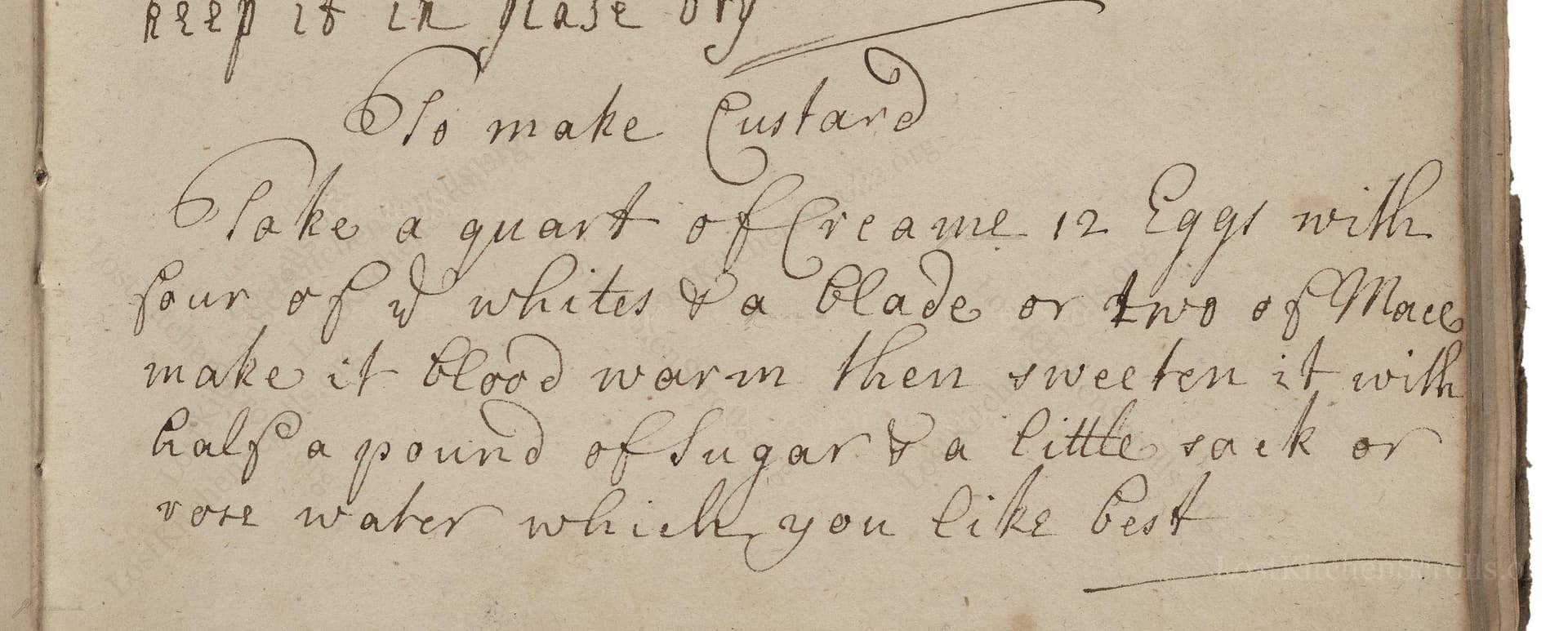To Make Custard
From the treasured pages of Cookery book of Jane Webb, compiled by several people
Written by Jane Webb

To Make Custard
"Take a quart of Creame. 12 Eggs with four of ye whites & a blade or two of Mace make it blood warm then sweeten it with half a pound of Sugar & a little sack or rose water which you like best"
Note on the Original Text
The recipe is concise and assumes a reader’s familiarity with basic techniques—a hallmark of manuscript cookery among literate women of the early 1700s. 'Blood warm' was a common culinary term meaning lukewarm, signifying the need for careful temperature control to avoid curdling eggs. Spelling is archaic but straightforward ('ye' meaning 'the'), and specific measurements gave way to experience, though this recipe helpfully provides proportions for eggs and sugar. The option between 'sack or rose water' reflects both taste and ingredient availability.

Title
Cookery book of Jane Webb, compiled by several people (1738)
You can also click the book image above to peruse the original tome
Writer
Jane Webb
Era
1738
Publisher
Unknown
Background
A delightful glimpse into the culinary world of early 18th-century England, this manuscript offers a playful array of recipes and kitchen wisdom, reflecting the tastes and ingenuity of its era.
Kindly made available by
Folger Shakespeare Library
This custard recipe hails from the handwritten household manuscript of Jane Webb, active between 1725 and 1750—an era when sugar, dairy, and eggs were prized kitchen staples in English gentry homes. The inclusion of 'sack' (an early sherry) or rose water showcases the period's penchant for perfumed and fortified ingredients. Creame and eggs would have come straight from estate farms, making such desserts emblematic of domestic abundance and refinement. Recipes like this were shared among women of status as symbols of cultivate taste and household prowess.

In the 18th century kitchen, this custard would likely have been made with large earthenware bowls for mixing, copper or tin pots on a wood-fired hearth for gently warming the cream, and a whisk made from bundled birch twigs or fine wooden rods. The final custard could have been set in ceramic or pewter dishes and baked in the gentle heat of a brick oven or over embers, possibly surrounded by a water bath to regulate the temperature.
Prep Time
15 mins
Cook Time
35 mins
Servings
8
We've done our best to adapt this historical recipe for modern kitchens, but some details may still need refinement. We warmly welcome feedback from fellow cooks and culinary historians — your insights support the entire community!
Ingredients
- 1 quart heavy cream
- 12 large eggs (use only 4 whites)
- 1-2 blades mace (or 1/2 teaspoon ground mace as substitute)
- 1 cup granulated sugar
- 2 tablespoons dry Sherry (sack) or rose water
Instructions
- To prepare Jane Webb's early 18th-century custard with modern technique and imperial units, begin by gently heating 1 quart of heavy cream with 1-2 whole blades of mace (or substitute with a generous pinch of ground mace) until just warm to the touch—do not let it boil.
- In a separate bowl, beat together 12 large eggs, but only use 4 of the whites to achieve a richer texture.
- Once the cream is warm and infused with the mace, strain out the mace and slowly whisk the cream into the beaten eggs, ensuring the mixture doesn’t scramble.
- Sweeten with 1 cup of sugar and add 2 tablespoons of either dry sherry (to mimic 'sack') or rose water, according to taste.
- Pour into a heatproof dish or individual ramekins.
- Bake in a bain-marie at 300°F until just set, about 30 to 40 minutes.
- Cool before serving.
Estimated Calories
380 per serving
Cooking Estimates
It takes about 15 minutes to prepare the custard and get everything ready. Baking takes around 35 minutes, and each serving has about 380 calories. This recipe makes 8 generous servings.
As noted above, we have made our best effort to translate and adapt this historical recipe for modern kitchens, taking into account ingredients nowadays, cooking techniques, measurements, and so on. However, historical recipes often contain assumptions that require interpretation.
We'd love for anyone to help improve these adaptations. Community contributions are highly welcome. If you have suggestions, corrections, or cooking tips based on your experience with this recipe, please share them below.
Join the Discussion
Rate This Recipe
Dietary Preference
Main Ingredients
Culinary Technique
Occasions

Den Bockfisch In Einer Fleisch Suppen Zu Kochen
This recipe hails from a German manuscript cookbook compiled in 1696, a time whe...

Die Grieß Nudlen Zumachen
This recipe comes from a rather mysterious manuscript cookbook, penned anonymous...

Ein Boudain
This recipe comes from an anonymous German-language manuscript cookbook from 169...

Ein Gesaltzen Citroni
This recipe, dating from 1696, comes from an extensive anonymous German cookbook...
Browse our complete collection of time-honored recipes



